A large proportion of miscarriages are classified as unexplained miscarriages since no cause is identified. No reliable biomarkers or treatments are available for these pregnancy losses. While our transcriptomic sequencing has revealed substantial upregulation of miR-146b-5p in unexplained miscarriage villous tissues, its role and associated molecular processes have yet to be fully characterized. Our work revealed that relative to samples from normal pregnancy, miR-146b-5p was significantly elevated in villous tissues from unexplained miscarriage patients and displayed promising diagnostic potential. Moreover, miR-146b-5p agomir contributed to higher rates of embryonic resorption in ICR mice. When overexpressed in HTR-8/SVneo cells, miR-146b-5p attenuated the proliferative, invasive, and migratory activity of these cells while suppressing the expression of MMP9 and immune inflammation-associated cytokines, including IL1B, IL11, CXCL1, CXCL8, and CXCL12. Conversely, inhibition of its expression enhanced proliferation, migration, and invasion abilities. Mechanistically, IL-1 receptor-associated kinase-1 and a disintegrin and metalloproteinase 19 were identified as miR-146b-5p targets regulating trophoblast function, and silencing IL-1 receptor-associated kinase-1 had similar effects as miR-146b-5p overexpression, while IL-1 receptor-associated kinase-1 overexpression could partially reverse the inhibitory impact of this microRNA on trophoblasts. miR-146b-5p may inhibit trophoblast proliferation, migration, invasion, and implantation-associated inflammation by downregulating IL-1 receptor-associated kinase-1 and a disintegrin and metalloproteinase 19, participating in the pathogenesis of miscarriage and providing a critical biomarker and a promising therapeutic target for unexplained miscarriage.
Summary Sentence
Overexpressed miR-146b-5p attenuates trophoblast proliferation, migration, invasion, and multiple cytokine expression by downregulating a disintegrin and metalloproteinase 19 and IL-1 receptor-associated kinase-1 in cases of unexplained miscarriage.
Graphical Abstract






